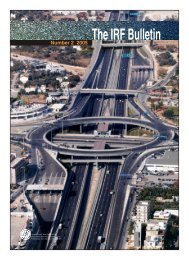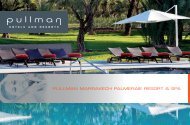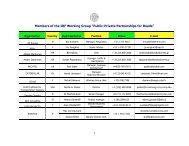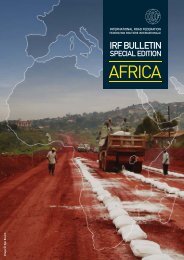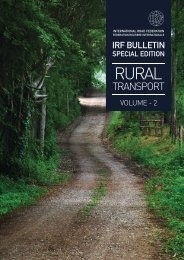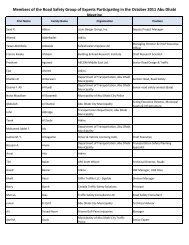Download - IRF | International Road Federation
Download - IRF | International Road Federation
Download - IRF | International Road Federation
You also want an ePaper? Increase the reach of your titles
YUMPU automatically turns print PDFs into web optimized ePapers that Google loves.
MATERIALS FOR ASIAN ROADS<br />
Design of bituminous mixes: bituminous concrete (BC)<br />
and semi-dense bituminous concrete (SDBC) are two<br />
major types of wearing courses used in the construction<br />
of flexible pavement. The Marshall method of mix design<br />
always begins with acceptance tests performed on<br />
aggregates and bitumen proposed to be used prior to<br />
undertaking the design. Different sizes of aggregates are<br />
blended to obtain aggregates of specified gradation.<br />
Marshall samples were prepared by varying the binder<br />
contents and tested for their volumetric properties.<br />
Bitumen holds the aggregates in position and the load is<br />
taken by the aggregates mass through the contact<br />
points. If all the voids are filled by bitumen, the load is<br />
transmitted by hydrostatic pressure through bitumen, and<br />
the strength of the mix, therefore, reduces. That is why<br />
the stability of mix reduces when bitumen content is<br />
increased beyond a certain value. Also at high<br />
temperatures during the summer season, bitumen melts<br />
and occupies the void space between aggregates. When<br />
the void space is not available, it causes bleeding. Thus,<br />
some amount of void is necessary in a bituminous mix,<br />
even after the final stage of compaction. For<br />
determination of optimum binder content (OBC), the<br />
values of bulk density, stability, air voids and voids filled<br />
with binder (VFB) are plotted against the binder contents.<br />
Bituminous concrete mix with impure chalk as filler:<br />
Marshall specimens were prepared with 3% impure chalk<br />
as filler. The mechanical properties of BC mixes with 3%<br />
impure chalk were determined. The binder contents,<br />
plotted against other properties of mix to obtain the<br />
optimum binder content (OBC) are presented in Figures<br />
2a and 2b.<br />
It was observed that the optimum binder content is<br />
5.75% by the weight of aggregates and 5.45% by the<br />
Stability, kg<br />
stab<br />
VFB<br />
1500<br />
1000<br />
80<br />
60<br />
40<br />
500<br />
0<br />
20<br />
0<br />
4.76 5.21 5.66 6.10<br />
Binder Content, Mix<br />
Fig. 2b: Property of BC Mix at 3% Chalk.<br />
weight of mix. The retained stability after 24 hours was<br />
found to be1078 kg. The stability of BC mix at OBC was<br />
found to be 1144 kg. The retained stability was found to<br />
be 94%.<br />
SDBC with chalk as filler: a mix design of SDBC with<br />
60/70 penetration grade bitumen was carried out as per<br />
the procedure given in AASHTO T-245 or ASTM: D-1559.<br />
Marshall specimens were prepared with varying bitumen<br />
contents of (4.5, 5.0, 5.5 and 6%). Bitumen and<br />
aggregates were heated thoroughly at about 160oC and<br />
150oC respectively and mixed together until the<br />
aggregate particles were coated. The aggregates and<br />
bitumen mixture was placed in a Marshall mould and<br />
each side compacted with 75 blows of Marshall hammer<br />
as per the procedure given in AASHTO T-245 or ASTM: D-<br />
1559. The bulk density was determined at ambient<br />
temperature. The stability and flow value of Marshall<br />
specimens were determined at 60oC. The binder<br />
content, plotted against other properties to obtain the<br />
optimum binder content (OBC) is shown in figures 4a &<br />
4b.<br />
VFB Percent<br />
bd<br />
av<br />
bd<br />
av<br />
Bulk Density, gm/cc<br />
2.350<br />
2.340<br />
2.330<br />
2.320<br />
2.310<br />
2.300<br />
2.290<br />
2.280<br />
4.76 5.21 5.66 6.10<br />
Binder Content, Mix<br />
8<br />
6<br />
4<br />
2<br />
0<br />
Air Voids, Percent<br />
Bulk Density, gm/cc<br />
2.320<br />
2.300<br />
2.280<br />
2.260<br />
2.250<br />
2.220<br />
2.200<br />
2.180<br />
4.31 4.76 5.21 5.66<br />
Binder Content, Mix<br />
12<br />
10<br />
8<br />
6<br />
4<br />
2<br />
0<br />
Air Voids, Percent<br />
Fig. 2a: Property of BC Mix at 3% Chalk.<br />
Fig. 4a: Property of SDBC Mix at 5.5% Chalk.<br />
<strong>IRF</strong> BULLETIN SPECIAL EDITION : ASIA & OCEANIA<br />
12



